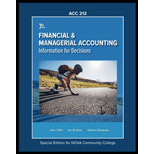
Concept explainers
Depreciation is the amount of decrease in the value of an asset within a set time period due to wear and tear of that particular asset. It helps in readjusting the actual cost of the particular asset o which the depreciation is applied.
Double Declining Balance Method:
It is a method of depreciation in which the rate of depreciation is double the rate of
Straight Line Depreciation:
Straight line depreciation is one of the methods of depreciation in which fixed rate of depreciation is provided throughout the course of depreciation on a particular asset.
Units of Production Depreciation Method:
This is a method of depreciation where the depreciation is not applied as straight line and is calculated with respect to the units that a particular asset produces gives.
The amount of depreciation.
Explanation of Solution
Given,
Cost of machine is $324,000.
Salvage value is $30,000.
Formula to calculate Depreciable cost:
Substitute $257,000 as cost of machine and $20,000 as salvage value,
Total depreciable cost is $294,000.
Computation of depreciation amount:
| Year | Straight line ($) | Units of production ($) | Double Declining Balance ($) |
| 1 | 58,800 | 71,120 | 128,750 |
| 2 | 58,800 | 64,080 | 64,375 |
| 3 | 58,800 | 63,400 | 32,188 |
| 4 | 58,800 | 68,720 | 12,187 |
| 5 | 58,800 | 26,680 | 11,990 |
| Total | 294,000 | 294,000 | 294,000 |
Working Notes:
Straight line method
Calculate Depreciation:
Depreciation that will be charged in the 4 years with respect to straight line method is $58,800.
Year 1
Calculate depreciation with respect to units of production:
Depreciation per unit is 0.2.
Computation of depreciation,
Depreciation that will be charged in the first year is $71,120.
Year 2
Given,
Units produced are $320,400.
Depreciation per unit is 0.2 per unit.
Computation of Depreciation:
Depreciation that will be charged in the second year is $64,080.
Year 3
Depreciation per unit is 0.2 per unit.
Computation of Depreciation:
Depreciation that will be charged in the third year is $63,400.
Year 4
Depreciation per unit is 0.2 per unit.
Computation of Depreciation:
Depreciation charged in the 4th year is $68,720.
Year 5
Depreciation per unit is 0.2 per unit.
Computation of Depreciation:
But the depreciation will be charged $26,680 only as depreciation can’t be charged on the salvage value of the asset.
Double Declining Balance method
Computation of Depreciation rate:
Double declining depreciation rate is 40%.
Year 1
Computation of depreciation in the first year:
Depreciation that will be charged in the first year is $129,600.
Year 2
Computation of book value in year 2:
Book value at the beginning of the second year is $194,400.
Computation of depreciation in the second year:
Depreciation that will be charged in the second year is $77,760.
Year 3
Book value of the asset in the year 2 is $194,400.
Computation of book value in year 3:
Book value at the beginning of the third year is $116,640.
Computation of depreciation in the third year:
Depreciation that will be charged in the third year is $46,656.
Year 4
Book value of the asset in the year 3 is $116,640.
Computation of book value in year 4:
Computation of depreciation in the 4th year:
Depreciation that will be charged in the 5th year is $27,994.
Year 5
Book value of the asset in the year 4 is $69,984.
Computation of book value in year 5:
Computation of depreciation in the 5th year:
But the depreciation charged will only be 11,990 as the depreciation can’t be charged from the salvage value of the asset.
Want to see more full solutions like this?
Chapter 8 Solutions
FIN & MANAGERIAL ACCT VOL 2 W/CONNECT
- Calculate the profit margin accountingarrow_forwardQuestion: 26.3 - At the beginning of the year, Downtown Athletic had an inventory of $200,000. During the year, the company purchased goods costing $800,000. If Downtown Athletic reported ending inventory of $300,000 and sales of $1,050,000, their cost of goods sold and gross profit rate must be ..........................................arrow_forwardExpert of Account Solve this asaparrow_forward

 AccountingAccountingISBN:9781337272094Author:WARREN, Carl S., Reeve, James M., Duchac, Jonathan E.Publisher:Cengage Learning,
AccountingAccountingISBN:9781337272094Author:WARREN, Carl S., Reeve, James M., Duchac, Jonathan E.Publisher:Cengage Learning, Accounting Information SystemsAccountingISBN:9781337619202Author:Hall, James A.Publisher:Cengage Learning,
Accounting Information SystemsAccountingISBN:9781337619202Author:Hall, James A.Publisher:Cengage Learning, Horngren's Cost Accounting: A Managerial Emphasis...AccountingISBN:9780134475585Author:Srikant M. Datar, Madhav V. RajanPublisher:PEARSON
Horngren's Cost Accounting: A Managerial Emphasis...AccountingISBN:9780134475585Author:Srikant M. Datar, Madhav V. RajanPublisher:PEARSON Intermediate AccountingAccountingISBN:9781259722660Author:J. David Spiceland, Mark W. Nelson, Wayne M ThomasPublisher:McGraw-Hill Education
Intermediate AccountingAccountingISBN:9781259722660Author:J. David Spiceland, Mark W. Nelson, Wayne M ThomasPublisher:McGraw-Hill Education Financial and Managerial AccountingAccountingISBN:9781259726705Author:John J Wild, Ken W. Shaw, Barbara Chiappetta Fundamental Accounting PrinciplesPublisher:McGraw-Hill Education
Financial and Managerial AccountingAccountingISBN:9781259726705Author:John J Wild, Ken W. Shaw, Barbara Chiappetta Fundamental Accounting PrinciplesPublisher:McGraw-Hill Education





